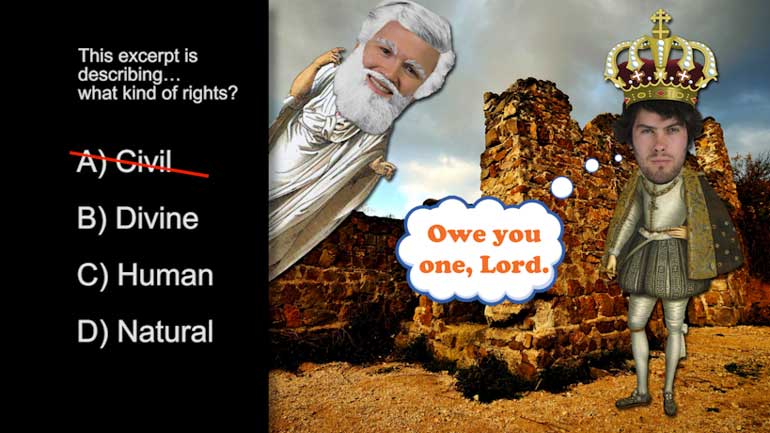ShmoopTube
Where Monty Python meets your 10th grade teacher.
Search Thousands of Shmoop Videos
History of Technology 6: Proto-Writing Systems 58 Views
Share It!
Description:
Proto-writing systems were great, but we're pretty sure your teacher isn't going to accept an essay in Cuneiform. Just a wild guess.
Transcript
- 00:02
Humanity’s first baby steps into the writing process are collectively called "proto-writing" [Evolution picture with the most modern man turning round and saying "stop following me"]
- 00:08
systems, which developed in the Neolithic age. [Examples of Neolithic writing]
- 00:12
The line between proto-writing and today’s writing is a squiggly, strange one that anthropologists [The Neolithic alphabet]
- 00:19
and archaeologists have drawn…
- 00:21
…Guess they didn't have a ruler handy… [Archaeologist and anthropologist playing naughts and crosses]
Full Transcript
- 00:24
Here are the two main differences…
- 00:26
For one thing, a fully developed writing system has to have a symbol for every sound in a [Drawing of man chucking a spear at an animal]
- 00:32
language.
- 00:33
That means that everything we say out loud can be transcribed into a written form. [Man talking as woman transcribes onto paper]
- 00:39
Proto-writing systems only have some of the sounds represented.
- 00:43
Proto-writing systems are also typically pictorial, which means that they rely on little drawings.
- 00:49
Most of those drawings directly represent their meanings, rather than representing them [Examples of drawings]
- 00:53
symbolically...
- 00:54
Like…they might have a symbol that represents porcupines, but not letters that represent [Man painting a portrait of a porcupine]
- 00:59
the sounds we make when we say that word.
- 01:03
Proto-writing may sound primitive to some, but we still use some forms of it today. [Examples of modern signage]
- 01:08
Like how about those little round headed people on bathroom doors?
- 01:11
We know which one is which because when they were made, way back when, girls equaled skirts, [Toilet doors with male and female signs on]
- 01:18
and boys equaled pants.
- 01:20
Guess the people who made those forgot about the Scots. [Man in a kilt walks into the wrong bathroom]
- 01:22
The other potential ancestors of modern writing were ancient number systems.
- 01:27
Counting probably started with cave folks counting on their fingers. [Man pointing to his fingers]
- 01:31
It’s useful to keep track of just how many saber-tooth tigers are prowling outside the
- 01:36
cave.
- 01:37
But eventually people moved on from fingers and toes and started making marks on stones or in clay
- 01:43
that represented numbers.
- 01:45
That same kind of symbolic thinking was useful in the development of symbols that represented [Man etching into a rock]
- 01:50
sounds.
- 01:51
So, eventually, these systems stewed together in the cauldron of human history and turned [Cauldron bubbling]
- 01:55
into a lovely soup of writing.
- 01:58
An…alphabet soup, perhaps…?
- 02:00
Anyway, this magical process happened in three different places around the world. [The Earth spinning]
- 02:04
To be fair, there's still some debate about the precise whens and wheres of the writing, but
- 02:08
what follows is a pretty good guess…
- 02:10
The earliest formal writing system was Sumerian cuneiform, which developed [Iraq is highlighted on a globe]
- 02:16
in modern day Iraq.
- 02:18
The Sumerians created a system of glyphs that directly represented things. [Pictures of glyphs]
- 02:24
They pressed these glyphs into clay tablets with reed styluses.
- 02:27
Later, the Sumerian written language got fancier, with glyphs being used to represent sounds. [Man drawing on a clay tablet]
- 02:34
One of the other really old writing systems began in China. [China highlighted on a globe]
- 02:38
Some people think they got the idea from the Mesopotamians…
- 02:41
But the Chinese probably mostly thought of it all on their lonesome. [Chinese man kicks Mesopotamian away]
- 02:46
The oldest examples of Chinese writing were found on these things called oracle bones. [Picture of an oracle bone]
- 02:51
The ancient Chinese would carve letters into ox bones with a bronze pin and then throw [Man carving into a bone]
- 02:56
the bones into a fire.
- 02:58
Afterwards, they would examine the cracks made in the bones to try and divine the future. [Man picks the bone out of a fire]
- 03:03
Sounds a lot cooler than the Magic Eight Ball.
- 03:06
And last but not least, writing was developed independently in Mesoamerica, which is modern [Mexico highlighted on a globe]
- 03:12
day Mexico and Central America.
- 03:14
This area was home to lots of advanced ancient civilizations like the Olmec, Maya, Aztec,
- 03:20
and more.
- 03:22
Many of these civilizations developed written languages that represented whole concepts, [Ancient kid drawing on a wall]
- 03:27
or even syllables of sound. [The kids mum hits him on the head for drawing on the wall]
- 03:29
And perhaps most importantly, these systems may have allowed people to spell their names
- 03:33
with a picture of a jaguar head.
- 03:35
Not gonna lie… we're kind of jealous… [Man signs a reciept with a jaguar head]
Up Next
GED Social Studies 1.1 Civics and Government
Related Videos
When you're about to marry the love of your life, not many things could stop you. However, finding out that your future hubby is keeping his crazy...
Here at Shmoop, we work for kids, not just the bottom line. Founded by David Siminoff and his wife Ellen Siminoff, Shmoop was originally conceived...
ACT Math: Elementary Algebra Drill 4, Problem 5. What is the solution to the problem shown?




